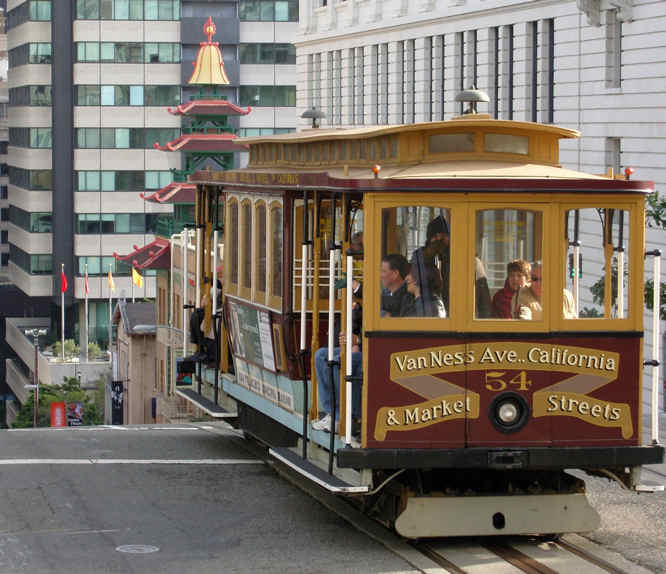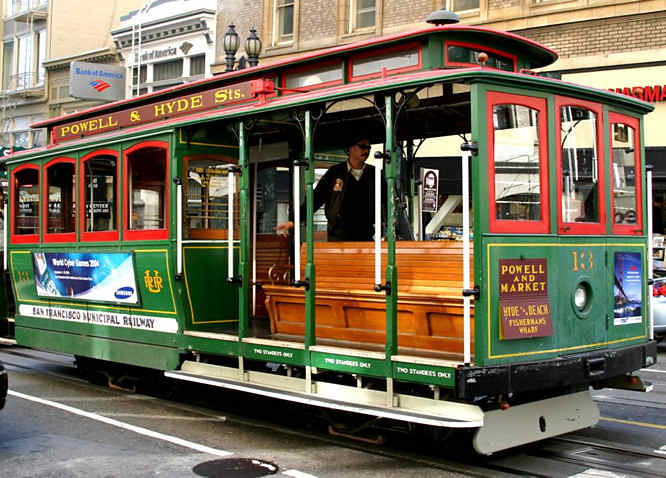San Francisco Cable Car
During your city break you must have a trip on the famous iconic San Francisco Cable car. There are 3 cable car lines the Powel/Hyde line, California line, and Powel/Mason line in San Francisco. They are an official national monument and a symbol of San Francisco. Do not be put off by the long queues. The experience is worth the wait. You pay the conductor on the car. You can buy an All-Day Pass from the conductor. They also sell three and seven day pass

A ride on the cable car is on most tourists wish lists. They like the idea of standing on the external running boards and holding on. This is not a good idea. Big trucks have a habit of overtaking the cable cars missing them by a few inches. Some tourists have been hit and injured. Others have had their day packs caught on the truck's wing mirrors and ripped off their backs or even been bodily pulled off the cable car and dragged along the road. Sit or stand inside the cable car.
There is a cable car turntable in Powell street at junction with Market street. It serves as the beginning cable car stop for the Powell-Mason line and Powell-Hyde line. Both these lines end near Fisherman's Wharf, but at different areas, Check the signs on the cable cars.
- The Powell-Mason line runs from that turntable, up and over Nob Hill and down to Bay Street at Fisherman's Wharf.
- The Powell-Hyde line also begins that turntable, and runs over Nob and Russian hills before ending at Aquatic Park near Ghiradelli Square.
- The California Street line runs East-West from the Financial District, through Chinatown, over Nob Hill and stops at Van Ness Avenue
The cable car started off as a horse-drawn system. It started back in August 1873, when the first cable car ran traveled along Clay Street. The cable car system was almost destroyed in the San Francisco Great Earthquake. Enormous cable wheels pull 11 miles of cable at 9.5 miles per hour. The cable cars move by clamping onto it and stop by releasing their grip.

In 1869 an Englishman called Andrew Smith Hallidie saw five horses dragged to their deaths when a horse-drawn streetcar slid backwards under its heavy load on slippery wet cobblestones on a steep San Francisco hill. His father had invented and manufactured a revolutionary heavy duty wire-rope. Hallidie had found uses for this technology in California's Gold fields. He designed and built a suspension bridge across Sacramento's American River using the wire-rope. He also used it for pulling heavy ore cars out of the underground mines on tracks. Hallidie adapted the technology to pull cable cars up San Francisco's very steep hills
You can board the cable cars at any of the turn tables at the beginning of the route. The cable cars will also stop at the brown and white cable car signs on its route to drop off and collect new passengers. The signs show the name of the cable car route and the direction the cable car is traveling e.g to Downtown (the financial district) or to Fisherman's Wharf. It will also show the final destination. Do not board the car while it is moving, wait for it to come to a complete stop. You can enter on either side of the car. You can board a cable car if there is sufficient space. You can 'hang on' to the special poles provided on the outside of the car but be very careful.
As a visitor attraction you can look around the San Francisco 'Cable Car Barn and Powerhouse'. It is at 1201 Mason Street, San Francisco, CA 94108 (corner of Mason Street and Washington Street.) You can view the actual cable winding machinery and see the cable entering the building and leaving underneath the street. There are various displays around the building. The best way to get to the powerhouse is by cable car. Car parking is nearly non-existent. The closest bus lines are the 1 AND 30.
Travel books

